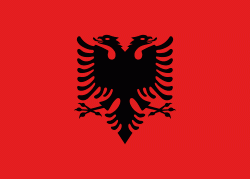Devoll District (Rrethi i Devollit)
Excavations at Tren cave unearthed Mycenaean Greek pottery of the Late Bronze Age. This appears to be of possible local manufacture.
The medieval era Devol fortress was the location where the Treaty of Devol between Bohemond I of Antioch and Byzantine Emperor Alexios I Komnenos was signed in 1108. Its site became forgotten in modern times, however it has been tentatively identified with the site Zvezdë (located at 40.71667°N, 20.85°W ), a conjecture already proposed by the 19th century British traveller William Martin Leake in 1835. Devol fortress was reconquered by the Bulgarian Empire in the beginning of the 13th century, but taken back by the Byzantines in 1259. The fortress continued to play an important role until the 14th century. Its site became forgotten in modern times.
In a text by Emperor John VI Kantakouzenos (r. 1347-1354) whose 'History' covers the years 1320-1356, there is mention of local Albanians; “While the emperor was spending about eight days in Achrida (Ohrid), the Albanian nomads living in the region of Deabolis (Devoll) appeared before him, as well as those from Koloneia (Kolonja) and those from the vicinity of Ohrid.” This meeting was estimated to have taken place at around February 1328.
During the First World War, the Greek army burned several Muslim villages in the region, including Sinicë (Miras). In the events of 1914, one of those killed by the Greek troops was Bektashi Baba Hafiz of the tekke of Kuç. His bloodstained ritual cap was portrayed as a symbol in the tekke for many years after his death.
The chapel in the Blashtonjë cave on the edge of the Small Prespa Lake dates to the 13th century AD. The cave paintings are the oldest artworks which have been found in Albania and the icons in the chapel are among the oldest of their kind in the country.
It was in Devoll, while the region was within the Serbian Empire, that Emperor Stefan Dušan died in 1355.
In late Ottoman times and early Independence era, much of the Christian population emigrated abroad and then returned, and later a part of the Muslim population did the same.
Before the Second World War, the Devoll valley was an autonomous district. In the Communist period, it belonged to the Korçë region, which it was separated from in 1990 as part of the reform of administrative divisions. In the territorial reforms of 2015, the municipalities of Devoll region were transformed into the new municipality of Devoll, which was placed within Korçë County.
Today, there is again mass emigration, although this time the local Muslim population is emigrating in larger numbers and higher proportions than the Christian population, a reverse of the "Kurbet" of the previous century.
Map - Devoll District (Rrethi i Devollit)
Map
Country - Albania
 |
 |
| Flag of Albania | |
Albania has been inhabited by different civilisations over time, such as the Illyrians, Thracians, Ancient Greeks, Romans, Byzantines, Venetians, and Ottomans. The Albanians established the autonomous Principality of Arbër in the 12th century. The Kingdom of Albania and Principality of Albania formed between the 13th and 14th centuries. Prior to the Ottoman conquest of Albania in the 15th century, the Albanian resistance to Ottoman expansion into Europe led by Skanderbeg won them acclaim over most of Europe. Albania remained under Ottoman rule for nearly five centuries, during which many Albanians (known as Arnauts) attained high-ranking offices in the empire, especially in the Southern Balkans and Egypt. Between the 18th and 19th centuries, cultural developments, widely attributed to Albanians having gathered both spiritual and intellectual strength, conclusively led to the Albanian Renaissance. After the defeat of the Ottomans in the Balkan Wars, the modern nation state of Albania declared independence in 1912. In the 20th century, the Kingdom of Albania was invaded by Italy, which formed Greater Albania before becoming a protectorate of Nazi Germany. Enver Hoxha formed the People's Socialist Republic of Albania after World War II, modeled under the terms of Hoxhaism. The Revolutions of 1991 concluded the fall of communism in Albania and eventually the establishment of the current Republic of Albania.
Currency / Language
| ISO | Currency | Symbol | Significant figures |
|---|---|---|---|
| ALL | Albanian lek | L | 2 |
| ISO | Language |
|---|---|
| SQ | Albanian language |
| EL | Greek language |















